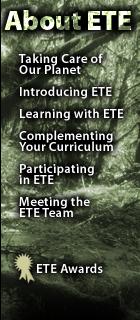 
|
The ETE modules complement your existing curriculum requirements because they incorporate many of the process and content goals that students need to learn while in your class. Process Goals Students should be able to solve problems and think critically. In each module students will encounter a situation, sometimes narrowly defined, but usually stated in such a way that students can define a focus that interests them--in line with the teacher's course objectives. Students should recognize there is a problem, state and define it, gather and analyze data, place findings in a written document or other product, and support and defend their findings, solutions, or recommendations. A major objective is to create an environment where students are workers and where they think, exercise creativity, and generate products. Content Goals
Science Standards The ETE series addresses many of the Science Education Standards from the National Research Council (NRC) and the 1993 Project 2061 Benchmarks for Science Literacy. For more information regarding Science Standards addressed in the ETE series, see additional National Science Standards resources online. |
|
|
Taking
Care of Our Planet ..|..
Introducing ETE ..|..
Learning with ETE ..|..
Complementing Your Curriculum ..|..
Participating in ETE ..|..
Meeting the ETE Team ..|..
ETE Awards
|
|
Discuss Exploring the Environment! Some images © 2004 www.clipart.com. Privacy Statement and Copyright © 1997-2011 by Wheeling Jesuit University/NASA-sponsored Classroom of the Future. All rights reserved. Center for Educational Technologies, Circuit Board/Apple graphic logo, and COTF Classroom of the Future logo are registered trademarks of Wheeling Jesuit University.
|